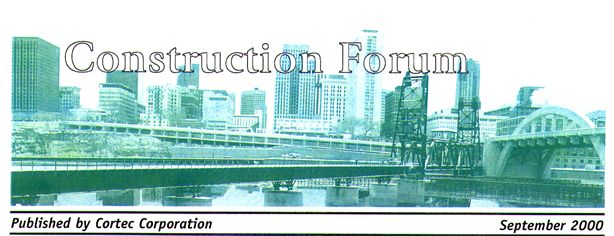CORROSION
INHIBITION OF STEEL REBAR IN CONCRETE
Prepared by Behzad Bavarian, PhD and Lisa Reiner
March 2000
Department of Civil and Manufacturing Engineering
College of Engineering and Computer Science
California State University, Northridge
Corrosion of steel rebar is the major cause
of concrete deterioration in reinforced and prestressed concrete
structures. This type of corrosion results when salts, water and
air are able to penetrate through the pores of concrete to the surface
of the steel. The key to inhibiting rebar corrosion is to restrict
the permeability of the concrete. Migrating corrosion inhibitors
(MCI) can reduce the corrosive ion mobility and neutralize these
corrosive species.
The corrosion inhibition of several commercially
available migrating corrosion inhibitors was investigated over a
400-day period. These investigations were made on steel rebar in
concrete totally immersed in 3.5% NaCl in ambient temperatures using
electrochemical monitoring techniques. Due to low conductivity of
concrete, the corrosion behavior of steel rebar had to be monitored
using AC electrochemical impedance spectroscopy (EIS). During this
investigation, changes in the resistance polarization and the corrosion
potential of the rebar were monitored to determine the degree of
effectiveness for Cortec MCI-2022.
This final report contains the corrosion test
results, specimen preparation, and the theory behind electrochemical
impedance spectroscopy (EIS) for the 10 specimens that were investigated.
The reinforced rebars (class 60 #4 steel wire) were cast in concrete
at one and two inches from the surface and allowed to cure for 28
days. The samples were then submerged in 3.5% NaCl solution for
the duration of the experiment. According to the ASTM (C876) standard,
if the open circuit potential (corrosion potential) is between 0
and -200 mV, this indicates a 90% probability that no reinforcing
steel has corroded. Corrosion potentials more negative than -350
mV are assumed to have a greater than 90% likelihood of corrosion.
However, this standard alone is not sufficient to demonstrate the
corrosion inhibition effectiveness of these MCI products in concrete
and should be used in concert with the EIS results.
During this investigation, samples were tested
once a week to measure the open circuit potential and resistance
polarization (Rp). Corrosion potentials were recorded at the beginning
of each AC impedance test. The Rp values obtained by curve fitting
data from the Nyquist plots in the EG&G M398 corrosion software
were used to estimate corrosion. The RP values are inversely proportional
to the rate of corrosion. A high Rp value could be an indication
of a low corrosion rate. The bode plots were also obtained from
this software to verify the RP value for each sample.
The MCI-2022 products have successfully demonstrated
corrosion inhibition of steel rebar in a 3.5% NaCl solution by maintaining
a high resistance polarization (low corrosion rate) for the rebar
in concrete. The observed corrosion rate was equivalent to the performance
of 304 & 3 16 stainless steel rebar in concrete. The non-treated
concrete samples showed a gradual decline in their resistance polarization,
indicative of the increasing corrosion.
The MCI-2022 products have successfully inhibited
rebar corrosion. The steel rebar corrosion potentials were maintained
at approximately -120 mV, and rebar resistance polarization reached
as high as 250,000 ohms. Both results indicate excellent corrosion
resistance performance. The observed corrosion rate was equivalent
to the performance of 304 & 316 stainless steel rebar in concrete.
The reference samples (non-treated) have shown a decline in their
resistance polarization and corrosion potentials, indicative of
corrosion.
In summary, the experimental results demonstrate
that the MCI-2022 products offer an excellent inhibiting system
for protecting reinforced concrete in an aggressive 3.5% NaCl solution.
The results are extremely promising for this product in its ability
to protect steel rebar in concrete in aggressive environments. The
construction industry should be duly informed on the advantages
of using this product.
|



